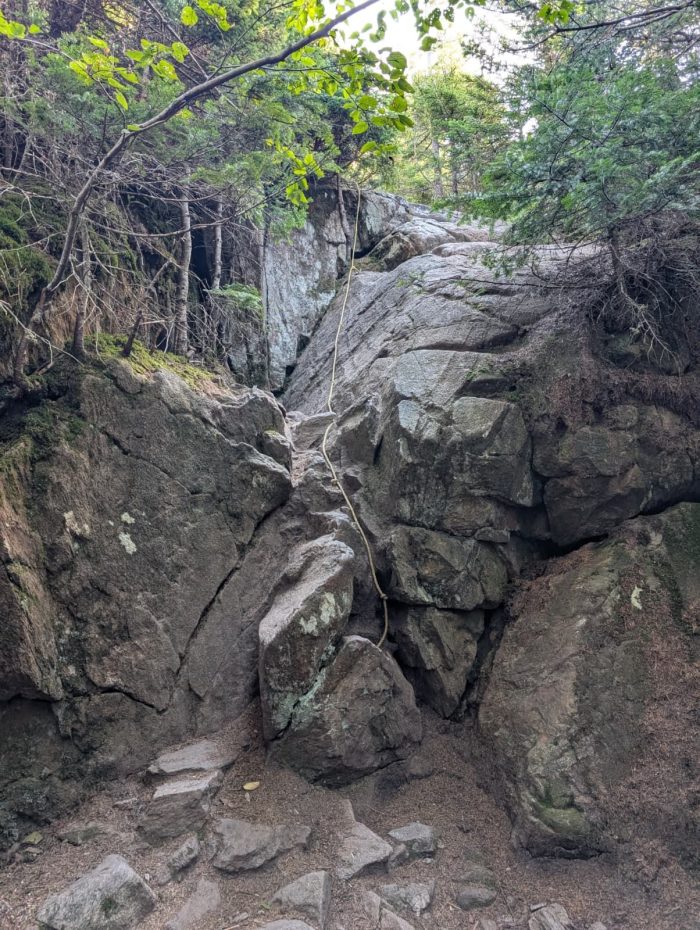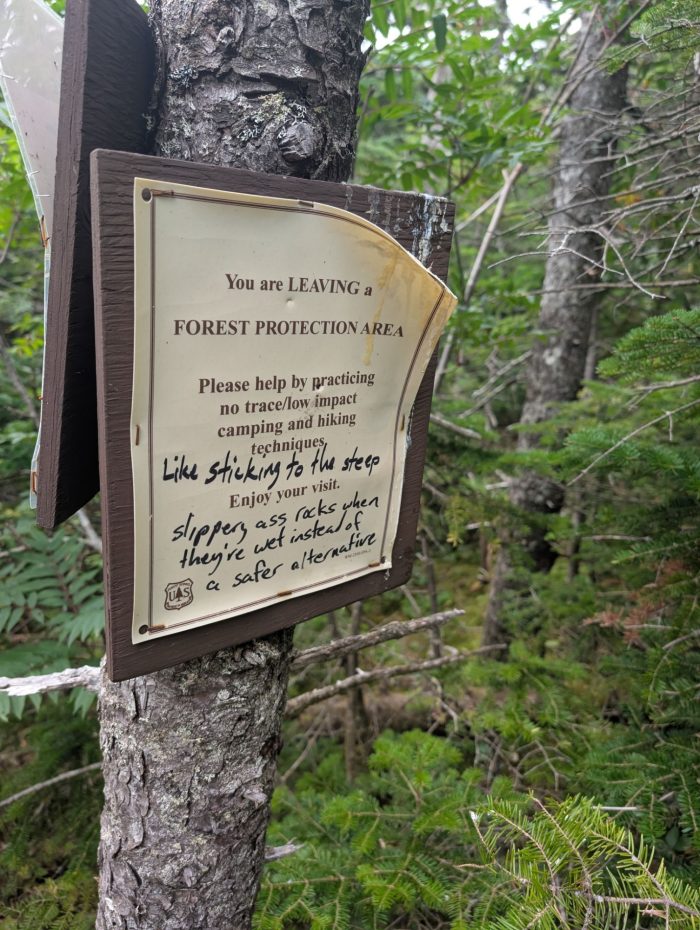Unfortunately, Maine is not flat. (Read this opinion article with a touch of sarcasm in everything.
Mountain Dew and I had fooled to match the word on the street around the 100 mile desert that are planes with the entire state being less mountainous than whites. This is simply not the case.
Have you heard of Mahosuc Notch?
Also unfortunately, one of the aspects of the path that is difficult to maintain is to investigate the path in advance. Some hikers enter with a head full of knowledge of the path from Georgia to Maine because they have been fascinated by the path for years. Others are ready to embrace the unknown and find what the path has to offer while we walk (that is me).
I had heard of a section of the AT where the arrows point to hikers through tight squeezes and indicate that hikers should drag under a rock to follow the white flames, and when Stoker went through NH and I ago a couple of months ago, he sent us his time through Mahosuc Notch. I really did not understand what that meant until today (I don’t ask too many questions about what comes on the way because I don’t want spoilers).
Mountain Dew and I have joked in the past on the ATC trying to kill us. With the path that goes directly because of the rock slabs that become slippery such as ice with any amount of humidity (or layers of pine needles), or cracks in the rock wide enough to be worrisome, Mountain Dew would point through the medium of the crack and say «I think I see a white fire! The ATC wants us to go there!» Of course, going through the middle of a crack would be nonsense. Slide the sliced exposed rock faces? That is standard.
The Mahosuc notch was the first time that we really pursued white clicks under huge rocks and jumping between rock faces with complete packages to cross the gorge, never touching the ground for a complete mile of «path.» Honestly, if you have experience in rock escalation, it is a very fun section. But I don’t think it makes any meaning as part of the AT.
Listen to me: the AT is redirected for blows and flooded areas all the time. The path changes as the environment does, and this year is no exception. We walk and on a super steep hill in Tennessee that was a redesign due to the damage of hurricanes in other places. The official wording of the path on the whites leads hikers to a shortcut that avoids both a missing bridge and the Wildcat mountains, where is the most steep mile on the path. There is even a blue fire around Mount Washington (and almost any other mountain peak in presidential) as an option for hikers who do not care about their maximum bag. Actually, you must choose to get out of the officer and blue Blaze to reach the top of many mountains along the path.
So why is there no alternative route around this path of path, probably the most dangerous and difficult mile of paths in more than 1900 miles? And while I am stripping: Why does the path not give the hikers the complete reward of reaching a peak, often crossing high enough like a mountain to tempt it with the option, but rarely it takes us all the way?
Do we like to overcome ourselves?
Or do they really hate hikers as they feel as if they do after walking almost 2000 miles on this path that cuts the hills up and down without taking into account the qualification or security?
Make notch can be an iconic trail mile, and many hikers have made a game by timing themselves «walking» through it (it really is more an effort of climbing in rock to be considered walking), but even in the topographic maps options in Farout (the application of the path of trails that we all use for the AT), there is no official group unless you want to leave and you The road.
Maybe the ATC is too purist, and perhaps the people who create maps in Farout are too. There are many paths that cross with the AT that appear as blurred lines that crawl to nothing (the bold red of the path whose map he paid is the only one that matters in this software) and, often, as Mountain Dew and I discover today, they are much better paths.
After the whites, the Wildcats and Maine’s first miles, our knees were speaking in protest. Literally, the first mile in Maine is one that includes several extremely steep bouletería projects, where trekking posts are brought along the way and where pine needles or wet conditions could be mortal. One (only one) of the faces of the rock had a courtesy rope like a wink to the ridicule of the path that climbed to his side. At one point, my foam pad tied to the bottom of my backpack was trapped while trying to run, and I almost bowed up on what could have been a serious injury at least. After that, I said «no thanks», for my own safety and well -being, I would take a self -directed blue fire instead of risking my knees giving way to the 3 podes between me and Mahosuc Notch.

Instant mountain dew and I stopped from the AT and started with a blue fire, the path was soft, qualified and finally we followed a stream that was running with clear, cold and delicious water. Meanwhile, the AT did not have direct access to water for 12 miles between where we started our day and where we plan to finish just after the notch. It was as if the ATC moved away the path of reliable water sources only by the fun of putting all three through a dangerous rocky glove.
We feel a bit claimed: all our jokes on AT always taking the worst possible route seemed more true than ever. Here, just one hundred meters from the official path was careful, beautiful path that led to the same exact place, and had running water! What about that?
Maybe I am not familiar with the story. I would love to learn more about the history of the path of the path in each state to better understand the folded masochist that the path takes. It has been a while since I heard the green tunnel podcast, so the next time I have wifi in the city, I will make sure to download more episodes to try to educate myself. Perhaps there really is a reason and consensus of the original creators of the path that the people who choose to walk should be challenged more than they would do on other paths. Or maybe modern trails feel that hikers these days are too soft and need to be shown what «good old days» of humanity mean by the outdoor hand. «In my day, we had to walk and Down the mountain just to go from one camp to another! Yes, we could have gone, but don’t worry about that. And no, there were no curves. The curves are for the weak. Guard that map and trust the white flames! – Probably something that someone in the ATC has said.
I am not angry with Mahosuc Notch, as I said, I really had a lot of fun. I would have a lot I preferred to make that section without a package of 30 pounds, so I did not harm the knees anymore when giving literal jumps to avoid falling in cavernous wells under the rock field. And yes, there is a way to completely avoid notch if you walk to the road on a side path. But for many hikers, this is an iconic part of the path that cannot be lost. I wonder, for how many hikers is this section of the path your last?
Does the ATC hate us?
While Mountain Dew and I joke, maybe the ATC has the reputation of maintaining, only 20-25% of all hikers who start the path end. Perhaps the routing of the path in the apparently possible way is its way of maintaining the title of exclusive AT Thruhiker and the elite. Although I don’t think they have a way to verify if a hiker is a blue in a difficult section. No, no, I will leave the punishment of that choice to any keyboard warrior who wants to tell me that I am not a true one through taking a blue fire or a road walking instead of taking each could white.
Anyway, that is enough to strip me. If you face yourself, you just know, there are easier and better outstanding paths, they are simply not for you.
Sarcastic/bitter tone. The sincere tone begins:
Of course, there are reasons for the AT to rise and raise the hills and not around it, usually due to the limits of private property depending on what they have told me. I am not sure of the original reason not to use curves on the path, but modern can be to reduce the trace of the path in the surrounding vegetation. Certainly does not help erosion not to use curves in Dirt Trail (in rocks less), so I am not sure that reasoning is maintained.
I would also like to emphasize that I have met many paths of trails and work teams along the way to the north from Georgia, and all hikers, of course, we appreciate and applaud their work deeply. It is incredible to see the extremely difficult work that is needed to do and maintain a trace, certainly more work than you need to walk. The hikers can only complain a lot, since without the path we would not be here. It is still fun to joke that ATC hates us, especially when we hear stories of PCT hikers about how much more difficult hiking in the AT is. I really wonder if the AT has a reputation to maintain and if that is a reason why we have Mahosuc notches on the road. I would love to interview someone at the ATC to learn more. But for now, I have my inanid writings that vary in tone depending on how my knees feel at the end of the day. 🦵
Speaking of paths of trails, I met one in a bar in Bethel, Maine today. I asked him some questions about the path, and he said that going directly through the hills «is just how we do things here.» Apparently, switches are a waste of time when going directly is simply more direct! 😁 He loves Mahosuc Notch, and we too. Welcome to Maine!




:max_bytes(150000):strip_icc():focal(995x352:997x354)/john-wwayne-gacy-michael-chernus-split-102025-b3db01f77a524276b0ab9b9c7b53abf3.jpg?w=238&resize=238,178&ssl=1)
:max_bytes(150000):strip_icc():focal(776x526:778x528)/nika-diwa-gender-reveal-tout-102025-f4bb4e78bb814772920184c9a78f11b9.jpg?w=238&resize=238,178&ssl=1)